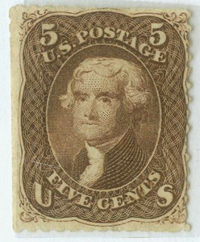
Discussion - Member to Member Sales - Research Center

Discussion - Member to Member Sales - Research Center

#35 and #35b are shown below - clearly there is a difference between the two:



Login to Like
this post
I should clarify that I'm working from two different Scott catalogues which may be the source of my difficulty. The 2019 catalogue I used is the worldwide Scott Standard Postage Stamp Catalogue; while, as I indicated in my initial post, my 2012 data comes from that year's edition of the Classic Specialized Catalogue of Stamps and Covers 1840-1940. Does the coverage of varieties differ by intention between those two types of catalogues? If anyone has the 2019 edition of the Classic Specialized for 1840-1940, would you mind seeing if #35b appears in it?
Thanks,
Jim

Login to Like
this post
The Scott Classic contains many more varieties than the Standard Catalog. Both varieties are listed in the 2015 Classic, which is the latest version that I have of that catalog.

Login to Like
this post

11:33:52am
That are also in my 2016 Classic, but not in my 2018 6 volume standard set.
As Michael points out, I think it is a question of the detail of the catalog edition, not the year.
Roy

Login to Like
this post
Thank you for your helpful responses. I should have tumbled to the difference in variety coverage at at the outset.
Quickly comparing the British Honduras entries in both kinds of catalogues I have at hand (ignoring the differences in publication years) confirms the different coverage of varieties - more in the Classic, though for British Honduras, at least, the majority apparently do also get included in the Standard. Color varieties are prime candidates for exclusion from the Standard, though even here some are included. Why #35b didn't make the cut for the Standard just isn't at all obvious to me. Oh well, I assume the Scott decision making in this regard is a black box.
Jim

Login to Like
this post
Scott also has removed many of the earlier major numbers for many countries for the 19th and early 20th Centuries and replaced them with minor varieties that are lower in value.
Why does Scott do this? Strictly for economics. Put more varieties in the Classic catalog and less in the standard catalogs = selling more Classic catalogs.

Login to Like
this post

I'm trying to understand when and why the Scott Catalogue dropped an 1891 British Honduras surcharge variety. The major stamp is #35, a Queen Victoria three pence stamp first surcharged with "3 cents" in 1888 and then surcharged again in 1891 with "five" and a bar through the "3". The 2019 Scott Catalogue has one variety #35a (double surcharged). But my 2012 edition of the Scott Classic Specialized Catalogue of Stamps and Covers 1840-1940 has a second variety #35b in which there is an extra space between the I and V in "Five". The catalogue values of #35b are significantly higher than those for #35. I assume that at some point between 2012 and 2019, the powers-that-be at Scott decided to ax #35b. Would anyone be able to help determine when that happened? I don't have any Scott catalogues for the intervening years. Also, is there any way to learn why the change was made?
#35 and #35b are shown below - clearly there is a difference between the two:



Login to Like
this post

re: Scott treatment of British Honduras 1891 surcharge variety
I should clarify that I'm working from two different Scott catalogues which may be the source of my difficulty. The 2019 catalogue I used is the worldwide Scott Standard Postage Stamp Catalogue; while, as I indicated in my initial post, my 2012 data comes from that year's edition of the Classic Specialized Catalogue of Stamps and Covers 1840-1940. Does the coverage of varieties differ by intention between those two types of catalogues? If anyone has the 2019 edition of the Classic Specialized for 1840-1940, would you mind seeing if #35b appears in it?
Thanks,
Jim

Login to Like
this post

re: Scott treatment of British Honduras 1891 surcharge variety
The Scott Classic contains many more varieties than the Standard Catalog. Both varieties are listed in the 2015 Classic, which is the latest version that I have of that catalog.

Login to Like
this post
BuckaCover.com - 80,000 covers priced 60c to $1.50 - Easy browsing 500 categories
08 Jan 2019
11:33:52am
re: Scott treatment of British Honduras 1891 surcharge variety
That are also in my 2016 Classic, but not in my 2018 6 volume standard set.
As Michael points out, I think it is a question of the detail of the catalog edition, not the year.
Roy

Login to Like
this post

re: Scott treatment of British Honduras 1891 surcharge variety
Thank you for your helpful responses. I should have tumbled to the difference in variety coverage at at the outset.
Quickly comparing the British Honduras entries in both kinds of catalogues I have at hand (ignoring the differences in publication years) confirms the different coverage of varieties - more in the Classic, though for British Honduras, at least, the majority apparently do also get included in the Standard. Color varieties are prime candidates for exclusion from the Standard, though even here some are included. Why #35b didn't make the cut for the Standard just isn't at all obvious to me. Oh well, I assume the Scott decision making in this regard is a black box.
Jim

Login to Like
this post

re: Scott treatment of British Honduras 1891 surcharge variety
Scott also has removed many of the earlier major numbers for many countries for the 19th and early 20th Centuries and replaced them with minor varieties that are lower in value.
Why does Scott do this? Strictly for economics. Put more varieties in the Classic catalog and less in the standard catalogs = selling more Classic catalogs.

Login to Like
this post

